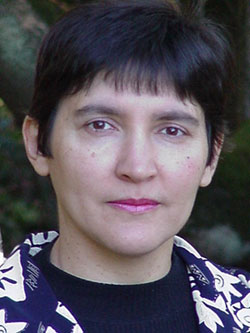BAFA © 2010. All material here is copyrighted. See conditions above. |
Lilia Valitova
composer, musician, Russia
|

|
I was born in 1960 in the Republic Bashkortostan in the former USSR. I graduated from the music high school for gifted children in Ufa city and then entered the Piotr Tchaikovski conservatory in Moscow in 1979.
I gained a Master of Arts in 1984 and a Ph.D. in 1989, studying composition under Professor Albert Leman and harmony under Professor Stepan Grigoriev. My dissertation was about a modal harmony in folk music. From 1987-2001 I taught composition and theory of music in the Conservatory of Ufa, becoming a professor in 1993.
My compositions have been performed in Estonia, Russia, Hungary, the Netherlands and the US. In 1998, I participated in the International Barlow Music Composition Endowment, Utah, U.S., and there my Preludes received special recommendation by the Gina Bachauer International Piano Foundation.
My music is polystylistic.
This means I use many different genres and styles.
|
For example, in my Preludes for piano, Prelude numbers V and IX are obviously written in an oriental style, whereas number VII is influenced by the music of Johann Sebastian Bach and also uses my own discoveries in modern harmony. I like to write in the genre of Prelude because it's one of the most mediated genres, where I can express any musical ideas I want. It also has a rich tradition: Bach, Chopin, Skrjabin, Rachmaninov, Debussy, Schostakovich and Hindemith. Really, the Prelude has a universal cosmopolitan character, close to all the cultures in the world.
The cycle for cello and piano Two Wings, which is dedicated to Bahá'í women, was written in what I call my French style. This style came from my listening to, analyzing and performing the music of French composers such as Lully, Couperain, Rameau, Debussy, Ravel and Poulenc. I also studied Early French music and French folk songs. This inspired me to write a piano cycle, which is made up of the arrangements of these melodies. It is called French Melodies and it is dedicated to my son Artur. I studied also Jewish folk and religious music. As a result, I wrote six piano cycles of the arrangements of these melodies, four of which are dedicated to the memory of the victims of Jewish Holocaust during the World War II. I have also piano arrangements of Chinese, Tatar, Russian, Arabic and Turkish folk melodies.
I have also written a piano cycle called The Three Valleys, which is based on The Seven Valleys and the Four Valleys by Bahá'u'lláh. It consists of three separate pieces called The Valley of Search (3 mins); The Valley of Love (3 mins, 40 secs); and The Valley of Contentment (4 mins, 30 secs). These are written in my oriental style, which has come out of a combination of factors. The first two pieces are in a style that developed from my studying the music of the Russian composers and also incorporates the Sufi style in the music of the Middle East. The Valley of Contentment is the result of my discovering Tatar folk music. I am ethnically a Tatar. Here, I bring together all my experience and the Sufi traditions in Tatar music. And I combine this style with the French style.
I like to work on piano, especially if I am writing for the piano. I like also to work for ensembles for piano and the other instruments. One of the examples of such works is my Two Wings for cello and piano. I like cello for its mellow sound, which is very close to the timbre of a human voice. In particular I like the form of the string quartet as a compositional form; although, so far, I have written only one composition in this form.
I have been greatly influenced by the French and Russian music traditions. I don't divide these traditions into periods; it's more important for me to find my own interpretations of them. When I started to develop my own style in music, I focused on piano, analyzing the piano music of different cultures, such as German, French, Russian, Polish and Hungarian. I started with an analysis of piano, but also other keyboard, music of the past few centuries, especially the 19th century. I focussed mainly on finding the special mellow touch, analyzing the performance of outstanding pianists of the 19 th and 20 th centuries, and going as far as traditional Eastern performers on string and percussion instruments.
I also use 'raga', 'maquam', and music for gamelan. These are the most important music traditions in India, the Middle East and Indonesia.
When I am developing a new style, I first pick up on the spirit of these traditions, and then these influence the melody, harmony, and sound of the piano I play when I compose. Because the piano originates from string and percussion instruments, I searched for new harmonies, melodies, touch and style in all folk musical traditions, especially in traditional string and percussion music. The traditional Chinese and Japanese, instrumantal styles are also very important for me, as are the folk and traditional music, both instrumental and vocal, of the Middle East, Far East, Middle Asia and South-East Asia. The Arabic and Jewish musical traditions are also very important for me. I use all the scales of Eastern music and European folk music that I know.
|

Arts Dialogue, Dintel 20, NL 7333 MC, Apeldoorn, The Netherlands
email: bafa@bahai-library.com
|
|
